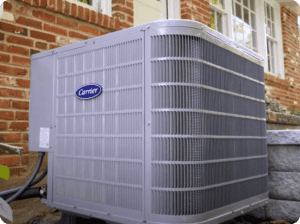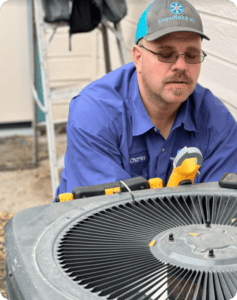2023 Increased HVAC Efficiency Standards- What They Mean for You
 New regulations from the Federal Government are going into effect as of January 1, 2023. These new standards increase the minimum SEER rating, a measure of efficiency, for all new residential and commercial HVAC systems. The bottom line you need to know is that these changes are going to increase prices on all new systems by as much as 30%, but it will also increase the energy efficiency, making these systems less costly to run- saving consumers and businesses money on their energy bills.
New regulations from the Federal Government are going into effect as of January 1, 2023. These new standards increase the minimum SEER rating, a measure of efficiency, for all new residential and commercial HVAC systems. The bottom line you need to know is that these changes are going to increase prices on all new systems by as much as 30%, but it will also increase the energy efficiency, making these systems less costly to run- saving consumers and businesses money on their energy bills.
Why Are There New Regulations?
The new regulations have come out to make a positive impact on the climate crisis by reducing overall energy consumption. In an effort to help consumers as well, there are also new tax incentives under the Inflation Reduction Act (you can read more about them by clicking here) that help make these systems more affordable, and to help encourage more people to upgrade their current systems to ones that use less energy overall.
Read More: If It’s Time For A New AC. A Heat Pump May Be A Better Choice
Impact on You
As you know, here in Idaho, your home heating and air conditioning energy use have the greatest impact on your monthly energy bills. When we get winter storms or a prolonged heat wave here in Boise, Nampa, or in the Mountains, everyone’s systems work harder, and we all expect to see a jump in our bill the next month as a result.
In general, systems that are more efficient have always cost more, but many people have opted for less efficient systems because they are less costly up front- and replacing a heating and cooling system is a major expense for any home or business. By mandating increased minimum standards, all new systems will have to be more energy efficient- and that means you’ll use less energy to be comfortable in your home.
This is just like the increase we’ve all seen in fuel efficiency standards for cars. The CAFE standards for cars require manufacturers to build more fuel-efficient vehicles. When you go to buy a new car, the gas mileage is likely much better on just about every car you look at, even larger SUVs, than it was in the past. That means you’ll use less gas than you’d use in your old vehicle every week, but you likely paid more for your new car than in the past as well.
SEER Explained
 SEER (Seasonal Energy Efficiency Ratio) is a way to measure the energy efficiency of HVAC systems. The Department of Energy has changed this system to a new measurement scale called SEER 2- but for most people, all you need to know is that previous systems could have efficiency ratings as low as 13, but that has been increased to 14 for all new systems in the North region, which includes us here in Idaho. In the Southwest, systems have to meet a SEER rating of 15 for both air conditioners and heat pumps.
SEER (Seasonal Energy Efficiency Ratio) is a way to measure the energy efficiency of HVAC systems. The Department of Energy has changed this system to a new measurement scale called SEER 2- but for most people, all you need to know is that previous systems could have efficiency ratings as low as 13, but that has been increased to 14 for all new systems in the North region, which includes us here in Idaho. In the Southwest, systems have to meet a SEER rating of 15 for both air conditioners and heat pumps.
Likewise, new heat pump systems will have to increase their heating efficiency as well. This is measured by a Heating Seasonal Performance Factor (HSPF), increasing the minimum efficiency to 8.2 under the old measurement system.
The new SEER 2 and HSPF2 standards measure efficiency a little differently, and have slightly different numbers, with a 14.3 SEER2 and a 7.5 HSPF2 minimum efficiency rating. These are equivalent to a SEER (1) rating of 15 and HSPF rating of 8.2 under the old calculations.
Read More: Why Is My AC Blowing Hot Air?
Why does the standard vary depending on where you live?
Different parts of the US have different climates, so how often you use your heating and A/C depends on the weather. However, the net impact of all those individual heaters and cooling units has a big impact on energy use and the environment. The regulations are regionalized, so standards are higher in the parts of the country where Air Conditioning is used most frequently, but are a little less strict in areas like ours where it doesn’t get as hot.
How The Regions Vary
The Department of Energy has divided the US up into three regions- North, Southeast and Southwest, with slightly different efficiency standards mandated in each region. Here in Idaho, we are part of the North region, and all systems manufactured after January 1, 2023 and installed will have to meet the new, higher standards of 14 SEER for Air conditioning unit and 15 SEER for all split heat pump units, regardless of where they are located.
What’s The Bottom Line?
If you need a new heating or air conditioning system, the good news is that you’ll still have a lot of systems to choose from, and even the least expensive options will be more efficient, and use less energy than before. But because of the increased efficiency and testing needed, these systems will likely be more expensive up front than they were in 2022. The trade off is that you will be using less energy to heat and cool your home, so your monthly energy expenditure will be less.
Read More: What Is The Best Way To Heat Or Cool A Home Office?
Don’t Forget the Tax Benefits
While new systems are going to be more expensive, there are also new tax incentives in place to help make these new systems more affordable. Tax credits and rebates are available to help make upgrading your system more affordable, and you’ll win in the long run, by having a better system that will keep you more comfortable while also using less energy.



